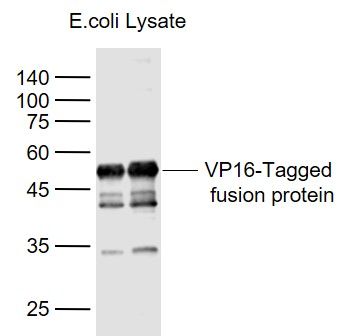HSV evades the immune system through interference with MHC class I antigen presentation on the cell surface, by blocking TAP or the transporter associated with antigen processing induced by the secretion of ICP-47 by HSV. In the host cell, TAP transports digested viral antigen epitope peptides from the cytosol to the endoplasmic reticulum, allowing these epitopes to be combined with MHC class I molecules and presented on the surface of the cell. Viral epitope presentation with MHC class I is a requirement for activation of cytotoxic T-lymphocytes (CTLs), the major effectors of the cell-mediated immune response against virally-infected cells. ICP-47 prevents initiation of a CTL-response against HSV, allowing the virus to survive for a protracted period in the host.
Function:
Transcriptional activator of immediate-early (IE) gene products (alpha genes). Acts as a key activator of lytic infection by initiating the lytic program through the assembly of the transcriptional regulatory VP16-induced complex composed of VP16 and two cellular factors, HCFC1 and POU2F 1. VP16-induced complex represents a regulatory switch: when it is on, it promotes IE-gene expression and thus lytic infection, and when it is off, it limits IE-gene transcription favoring latent infection (By similarity).
May play a role in the aggregation of tegument proteins around nucleocapsids during virus morphogenesis.
Subunit:
Interacts with VP22. Interacts with gH (via SLCterminus). Interacts with the virion host shutoff protein (vhs). Interacts with VP11/12. Associates with the VP16-induced complex; binding to host HCFC1 activates VP16 for association with the octamer motif-binding host protein POU2F1, to form a multiprotein-DNA complex responsible for activating transcription of the viral immediate early genes (By similarity).
Similarity:
Belongs to the herpesviridae tegument protein VP16 protein family.
SWISS:
P04486
Gene ID:
VP16 tag
Database links:
SwissProt: P04486 Human herpesvirus 1
| Picture |
Sample:
Lane 1: VP16-Tagged Fusion Protein Overexpression E.coli Lysate (Cat#: SL41403P) at 2ug
Lane 2: VP16-Tagged Fusion Protein Overexpression E.coli Lysate (Cat#: SL41403P) at 4ug
Primary: Anti-VP16 tag (SL2111R) at 1/1000 dilution
Secondary: IRDye800CW Goat Anti-Rabbit IgG at 1/20000 dilution
Predicted band size: 51 kD
Observed band size: 51 kD
|
|
|
